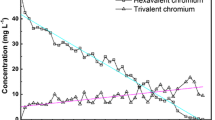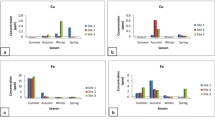Abstract
The presence of copper in the growth medium induces the biosynthesis of several low-mol-wt copper ogano-chelators inAspergillus fumigatus andPenicillium chrysogenum. By use ofP. chrysogenum, we were able to prepare several low-mol-wt metallothionein chelators, as well as several short-chain copper chelatins. The amino acid composition of a chelatin of mol wt approx 799 Da revealed the presence of cysteine, glutamic acid, glycine, and leucine. Use ofA. fumigatus led to fewer copper chelators and one very short-chain peptide: a chelatin of mol wt approx 624 Da. composed of four amino acids, asparagine, glutamic acid, cysteine, and glycine. These results may confirm our assumption that fungi detoxify the deleterious action of toxic elements by producing high levels of heavy metal chelators/chelatins.
Similar content being viewed by others
References
A. G. Massey, inComprehensive Inorganic Chemistry, vol. 3, J. C. Bailar, Jr., H. J. Emele’us, R. Nyholm, and A. F. Trotman-Dickenson, eds., Pergaman Press, Oxford, 1973, pp. 1–78.
U. Weser,Metalloproteins. Georg Thieme Verlag Stuttgart, New York, 1979.
R. Premakumar, D. R. Winge, R. D. Wiley, and K. V. Rajagopalan,Biochim. Biophys. Acta,493, 465–477 (1977).
R. Prinz and U. Weser,Z. Physiol. Chem. 356, 767–776 (1975).
D. E. Salt, D. A. Thurman, A. B. Tomsett, and A. K. Sewell,Proc. R. Soc. Lond. B 236, 79–89 (1989).
A. A. Razak, M. A. El-Meleigy, and E. A. Ghonamy,Az. J. Microbiol. 8, 225–235 (1990).
A. A. Razak, E. A. Ghonamy, and M. A. El-Meleigy,Az. J. Microbiol. 8, 249–258 (1990).
S. E. Ramadan, A. A. Razak, A. M. Ragab, and M. A. El-Meleigy,Biol. Trace. Elem. Res. 20, 225–232 (1989).
O. H. Lowry, N. J. Rosebrough, A. L. Furr, and R. J. Randall,J. Biol. Chem. 193, 265–275 (1951).
A. A. Razak and S. E. Ramadan,Egypt. J. Microbiol. 19, 193 (1984).
A. M. Ragab, S. E. Ramadan, A. A. Razak, and E. A. Ghonamy, inPerspectives in Biotechnology and Applied Microbiology, D. I. Alani and M. Mooyouny, eds., Elsevier, London, 1986, pp. 343–353.
A. A. Razak, S. E. Ramadan, A. M. Ragab, and M. A. El-Meleigy,J. Fac. Edu. Ain Shams Univ. 13, 433 (1988).
A. A. Razak, S. E. Ramadan, and K. El Zawahry,Biol. Trace Elem. Res. 25, 193–199 (1990).
I. M. Abbass and A. A. Razak,Biol. Trace Elem. Res. 28, 173–179 (1991).
Author information
Authors and Affiliations
Rights and permissions
About this article
Cite this article
El-Meleigy, M.A. Copper organo-chelators inAspergillus fumigatus andPenicillium chrysogenum . Biol Trace Elem Res 34, 177–183 (1992). https://doi.org/10.1007/BF02785245
Received:
Accepted:
Issue Date:
DOI: https://doi.org/10.1007/BF02785245




